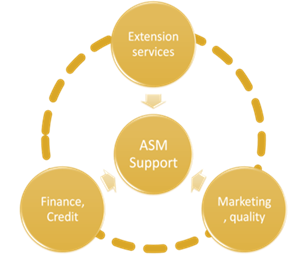
Chad ASM Profile Political Economy & Strategic Standpoints | Social and Environmental Factors | Local linkages | ASM Sites in Chad
The ASM population in Chad is estimated at 300,000, mostly located in the Tibesti region in the Northern part of the country. Chad’s gold deposits are spread over 1 200km from the South to the Western part of the country. ASM operations are located around 40 sites dominated by informality and alluvial operations. The Tibesti region attracts many miners since the 2013 gold rush, where recently clashes have been recorded between the local community and artisanal miners - mostly of foreign origin. Like in many countries from the Sahel region ASM has seen a surge in numbers especially from youth. The most recent gold rush was in the Batha region in 2016 where clashes were recorded between miners and the army. Overall ASM activity remains significantly overshadowed by oil production.
Chad is one of Africa’s largest countries and with an extensive mineral potential, it harbor’s the 10th largest oil reserve on the continent estimated at 1,5billion barrels. Petroleum is the country’s major source of revenue making up 60% of the Chadian revenues. In 2013, the hydrocarbon sector accounted for 90% of exports - more than 70% of Government revenues - and about 30% of the nominal gross domestic product. However, the mining sector remains underdeveloped dominated by natron and gold production.
Mineral exploitation remains limited despite known potential. Identified greenstone belts are located in the southwest of the country and include the Mayo Kebbi belts (containing the Lere, Mourbame and Pala areas). Gold has also been found in the Quaddai region (including the Am Ouchar, Ade, Ardelik and Goz Beida areas). These regions have been linked to the gold bearing Birimian rocks of West Africa. Natron, commonly known as Sal Soda is currently the only other vastly ASM exploited mineral in Chad, mostly used for washing, preservatives, medicine and soap manufacturing, natron mining activities are concentrated around lake Chad. Small scale exploitation of Tungsten in the Tibesti mountains is also on record.
Country Mining Vision Status
CMV Processes Underway.
Policies, Laws and Regulations Currently in Effect
Chad mining code, 1995 (CURRENTLY UNDER REVIEW)
ASM Associations or Cooperatives
NONE
ASM Definition Criterion
Type of operation (e.g. alluvial or primary mining); number of miners; size of operation
ASM Licensing
Artisanal: YES
Small Scale Mining: YES
ASM Minerals or Metals Exploited
Precious Metals Gold, Silver
Base Metals Tin
Precious Stones Diamonds
Development Minerals Bauxite, Quarts, limestone, Granite
ASM SUPPORT TRIANGLE

Mining Code Provisions for Women in ASM
Mining code 1995, Title 9. Contestations, Infractions and Penalties; Article.96.
Investigations, Seizures, Searches and Body Searches:
Female body searches can only be performed by a doctor or a female.
Mineral Policy of Chad :
Issue: Underdeveloped mining industry leading to a lack of diversification
Policy Objectives :
Enticing foreign investors and mining companies
Policy Statement:
I. Ensure maximum control of revenues from the exploitation of Chadian natural resources;
II. Fight against corruption which particularly impedes the sector on the international scale.
Policy environment:
For a long period of time the Government has been focusing on supporting a mineral policy centered on the exploration and development of domestic hydrocarbons. Chad holds untapped potential in mineral production and value addition of petroleum. New policy is trying to encourage diversification of the economy which remains over reliant on petroleum.
Ensuring more transparency, equitable, optimal exploitation of natural resource that will support the country’s development and its socioeconomic development is of paramount importance for policy makers.
As part of the AMV domestication process (CMV processes) in Chad, the new mining law aims for sustainable growth, developing the country with a solid mining sector and making it ecologically and socially responsible.
Finance and credit
There are no specific provisions for artisanal miners financing or credit facilities in Chad. Part of the 2013-2015 national plan was targeted at increasing finance and credit facilities for the general population. However, the 2017-2021 national development plan gives more attention to finance and credit in the mining sector. According to the IMF (2011) compared to other Sub-Saharan African countries with low income, in Chad credit to the private sector is limited. Overall, the finance sector lacks development and micro-credit had a minimal market infiltration at only 3% in 2010.
Extension services - a phased approach to integration and capacity-building
In Chad’s most recent history, much industrial development centered around the exploitation and production of oil. In Chad, value-addition is at the very early stages, mainly in jewellery with gold. With iron produced artisanally, small scale agriculture tools and knives are created. A local NGO works with artisans in the use of local material for fabrication of agricultural tools. With minerals such as Natron, home production of soap for local usage is prevalent. In the mining code there is provision for local value addition of mineral production, however there are limited enforcement mechanisms.
Marketing and quality
With the dominance of oil production other sectors such as gold and natron exclusively mined through ASM methods have not developed market orientated practices. The country has seen very little development in that sector; this is mainly due to the focus on hydrocarbons.

